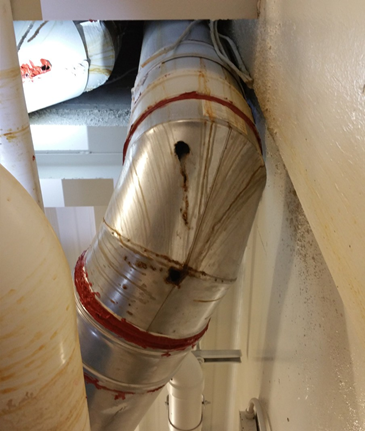Most chimneys on the market are leaking. Fact.
A common reaction might be something like, “Not me; my chimneys are listed.” The costly reality is, in certain instances, testing standards for chimney joint sealants DO NOT protect you.
Even many listed chimneys leak not only condensation but also dangerous flue gases. For the contractor or specifying engineer, this means liability and financial risk. It’s happening more than you think. There’s something going on with some of the most commonly used chimney joint/sealant materials and it must be addressed.
Chimney joint sealants: leakage & test standards
Silicone Rubber, Vitonand Ceramic Cement are common sealant materials used to seal chimneys. Chimneys that use these materials are tested against ‘leakage limits’ set by listing agencies such as UL, Intertek, etc. The chimneys pass, and engineers specify those materials because the manufacturer said it’s a good idea. But somehow after installation, we often see a very different story.

Corrosion or hairline cracks at the chimney joint can cause leakage after installation - and after the manufacturer’s warranty has run out. Oftentimes the contractor or specifying engineer doesn’t even know it’s happening; yet, they take the blow for it.
If the products are listed, how can a chimney material pass a test, and then one year later start leaking? The test standards for modern chimney joint sealant materials – now more than 20 years old – are not in sync with real-life situations where condensation, high temperatures and varying pressures are at play.
There are a number of reasons why listed chimneys leak and why you can’t just always go with the manufacturer’s recommendation. Some of the facts around chimney testing standards cannot be ignored. For example:
A cure for chimney leakage
The rate of chimney leakage was unacceptable, not to mention costly. So in 2014, we partnered with Underwriters Laboratories (UL) to show that a graphite chimney joint, as used in the EPS PowerStack™ chimney system, is a much more reliable design for mitigating chimney leakage and associated risk.
Our research revealed proof that graphite gaskets are superior to other joint sealant materials when exposed to real-life conditions:
Compared to Ceramic Cement,
Compared to Silicone,
It’s not just the graphite sealant
Joint assembly and human error during installation play a critical role in the safety and performance of your chimney system. There are things you can do to protect your chimney application from leakage and ensure it will stand the test of time.
Remember, just because a chimney is listed and recommended by the manufacturer does NOT mean your chimney application is protected against leakage.
Get the facts about testing standards for chimneys, plus advice for maximum chimney performance, in this Technical Brief: